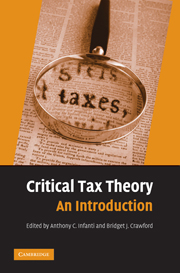Book contents
- Frontmatter
- Contents
- List of Illustrations
- List of Tables
- List of Contributors
- List of Common Abbreviations
- Introduction
- CHAPTER 1 FOUNDATIONS OF CRITICAL TAX THEORY
- CHAPTER 2 HISTORICAL PERSPECTIVES ON TAXATION
- CHAPTER 3 THE GOALS OF TAX POLICY
- CHAPTER 4 CRITICAL TAX THEORY MEETS PRACTICE
- CHAPTER 5 RACE AND TAXATION
- CHAPTER 6 GENDER AND TAXATION
- CHAPTER 7 SEXUAL ORIENTATION AND TAXATION
- CHAPTER 8 THE FAMILY AND TAXATION
- CHAPTER 9 CLASS AND TAXATION
- CHAPTER 10 DISABILITY AND TAXATION
- CHAPTER 11 GLOBAL CRITICAL PERSPECTIVES ON TAXATION
- CHAPTER 12 CRITICAL PERSPECTIVES ON CRITICAL TAX THEORY
- Redistributive Justice and Cultural Feminism
- Taking Critical Tax Theory Seriously
- A Feminist Perspective on the QTIP Trust and the Unlimited Marital Deduction
- Caring Enough: Sex Roles, Work, and Taxing Women
- Index
A Feminist Perspective on the QTIP Trust and the Unlimited Marital Deduction
Published online by Cambridge University Press: 04 August 2010
- Frontmatter
- Contents
- List of Illustrations
- List of Tables
- List of Contributors
- List of Common Abbreviations
- Introduction
- CHAPTER 1 FOUNDATIONS OF CRITICAL TAX THEORY
- CHAPTER 2 HISTORICAL PERSPECTIVES ON TAXATION
- CHAPTER 3 THE GOALS OF TAX POLICY
- CHAPTER 4 CRITICAL TAX THEORY MEETS PRACTICE
- CHAPTER 5 RACE AND TAXATION
- CHAPTER 6 GENDER AND TAXATION
- CHAPTER 7 SEXUAL ORIENTATION AND TAXATION
- CHAPTER 8 THE FAMILY AND TAXATION
- CHAPTER 9 CLASS AND TAXATION
- CHAPTER 10 DISABILITY AND TAXATION
- CHAPTER 11 GLOBAL CRITICAL PERSPECTIVES ON TAXATION
- CHAPTER 12 CRITICAL PERSPECTIVES ON CRITICAL TAX THEORY
- Redistributive Justice and Cultural Feminism
- Taking Critical Tax Theory Seriously
- A Feminist Perspective on the QTIP Trust and the Unlimited Marital Deduction
- Caring Enough: Sex Roles, Work, and Taxing Women
- Index
Summary
Professor Lawrence Zelenak's article, Taking Critical Tax Theory Seriously [earlier this Chapter], scores many points, but I am nevertheless moved to critique the part of the article that relates to the [qualified terminable interest property (QTIP)] trust and the marital deduction. I also have some bones to pick with feminist scholarship in this area, namely, its innuendos of a male chauvinist plot, its general inattention to the QTIP trust problem, its acquiescence in the unlimited marital deduction, and its failure to come up with a plausible solution. The foregoing critiques tend to validate Professor Zelenak's thesis that critical tax scholarship betrays a “whiner” mentality: (1) critical tax scholarship obsesses over tax provisions it does not like while ignoring the larger context, and (2) it is weak on plausible solutions.
INTRODUCTION
The full value of the QTIP trust qualifies for the gift or estate tax marital deduction even though the transferee spouse (the “wife” or “widow”) has only a right to income for life, with no powers of disposition or control. The “price” to be paid for full qualification for the marital deduction is that the QTIP trust property is included in the wife's unified estate and gift tax base, although the burden of the tax “on” the QTIP trust is usually borne by the trust itself and not the wife's own estate.
Both the QTIP trust device and the unlimited marital deduction entered the estate and gift tax as a “package” in the Economic Recovery Tax Act of 1981 (ERTA). The link between the two was explicit.
- Type
- Chapter
- Information
- Critical Tax TheoryAn Introduction, pp. 381 - 384Publisher: Cambridge University PressPrint publication year: 2009
- 1
- Cited by



